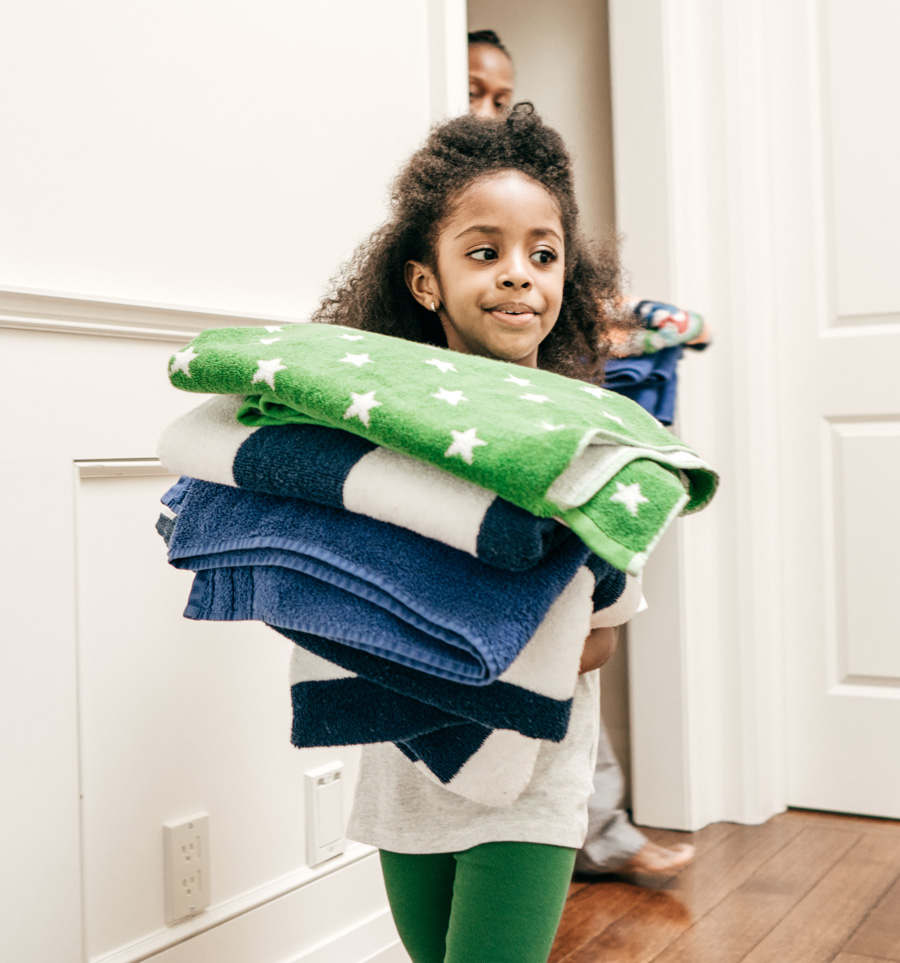

by Vicki Bentley
R
aising kids who help at home is about more than just getting the chores done. It’s about training your children to be responsible members of a family who diligently serve one another. It’s about discipling—or apprenticing—them in living skills. Remember: you have years to develop your children’s character, so don’t overwhelm them with unrealistic expectations. As the sign near my front door reminds me and our guests during this season of training:
“My house is clean enough to be healthy, and messy enough to be happy.”

Here are some things I can do within my household to make it easier for them to succeed:
1
Have a routine. Children need the security of knowing what to expect in their day. This does not have to be a rigid structure, and you may not always adhere to it, but at least you have a plan.
2
Have a place for everything. Young children have a responsibility to pick up; it is overwhelming for them to have to “figure out” where something might belong. A five-minute pick-up with the kitchen timer setting the pace can be a fun game when everything has a place. Of course, older children should have input into (or total responsibility for) organizing their own spaces, such as their room or closet.
3
Don’t put it down; put it away. This was just one of the little sayings my children learned to parrot through the years. (Others included, “If you don’t have time to do it right, you sure don’t have time to do it over!”) Did you realize that if you spend ten minutes each day looking for misplaced items, you spend more than sixty (yes, 6-0) hours each year looking for stuff?
4
Store items closest to point of use. Notice if you or your children habitually must go somewhere else to get what is needed to accomplish a task. Ask yourself if it can be stored closer at hand, or if it would be practical to have a duplicate item to keep at the task location. Ask yourself: Where would we look for this? Where do we most often use this?
5
Label, if necessary! If it will help, affix labels on the cabinet doors to designate the “homes” for various items.
6
Dots on laundry. Sorting clean laundry into stacks for the correct children went quickly when we dotted clothes with laundry pens or permanent markers: the oldest child (#1) had one dot on the tag of her shirt or the waistband of her pants or the toe of her socks, the second child had two dots, and so on. As an item was handed down, we simply added a dot.
7
Laundry the “right” way. Train children to turn clothes right side out, take their socks off right side out, sort their clothes into appropriate baskets—one for colored clothes, one for whites, one for darks, one for linens/towels, (or whatever works best for your household). And fold straight out of the dryer—practically no wrinkles!
8
Color code. Assign each child a color and buy towels, napkins, cups, etc. in those colors. You will easily know whose towel is on the floor, which basket the math book goes into, which file the papers go in, etc.
9
Spray bottles. These make clean-up so much more fun!
10
Set a timer. Set the kitchen timer for a five-minute pick-up and have everyone go quickly through the house to see how many items can be put away in that time period. Or set the timer for fifteen minutes to work on weekly chores, then take a fifteen-minute snack break or story time break before resuming your efforts. What seems like an unending task is often only a matter of minutes, and the timer can help your children realize that the job really isn’t that overwhelming.
11
Help keep rooms manageable. Set aside time for periodic assessments of their rooms. Some children need more guidance to purge or reorganize their belongings, and it can be an overwhelming task without your step-by-step encouragement.
12
Ask older kids what they need. Do they have the containers or shelving they need? What is working and what is not? What areas are hard for them to stay on top of and why?
13
Consider taking toys out of kids’ rooms and having a toy closet or central playroom. A childhood friend’s room was totally devoid of anything but cheerful beds, dressers, and a cushy rug. When we wanted to play a game or with a toy, we went to the closet in the hall and got the game or toy, took it to the rug, and then put it back in the closet when we were done. Also, when the closet was full, they had “enough” toys.
Another option is to select a handful of toys and books to keep out, then store the rest away. Every six months, trade the toys on display with some of the toys in storage, and it will seem to your children that they have all new playthings!
14
Keep an eye on the inventory. If your children have too many toys to put away, or too many clothes to keep in the drawers or closet, consider giving new homes to some of those items. Watch the clothes that always end up back in the laundry—those are the ones they like to wear. And which toys are always underfoot? Could you give away, or pack away, some of the others?
15
Make your house child-friendly. If you want them to fix their own breakfast, put the cereal or other breakfast items where they can reach them. Put dishes in a cabinet low enough for them to set the table or get their own drinks. (Unless you are trying to avoid this!) Other suggestions:
- Low bins
- Step stools
- Low clothes racks
- Coat or bookbag hooks
- Accessible storage
- Bunk-blankets or comforters in duvet covers
- Dishpans or divided storage for books

One last thing…
Some of you may be thinking, “But my kids are little. If I assign chores, I’ll just be the one who ends up doing them all.” Hmmm, valid point. But if you don’t implement some sort of home management training, the children aren’t being mentored in responsibility and skills, and you’ll still end up as the one who does all the work. This way, you are training them so that you can eventually reap the reward of delegating some of the tasks. And more importantly, you may be making an eternal impact on a little heart.
Don’t forget to have a sense of humor as you train your children in these life skills. It will make it less stressful for you all!

Adapted from The Everyday Family Chore System by Vicki Bentley, at: www.everydayhomemaking.com
